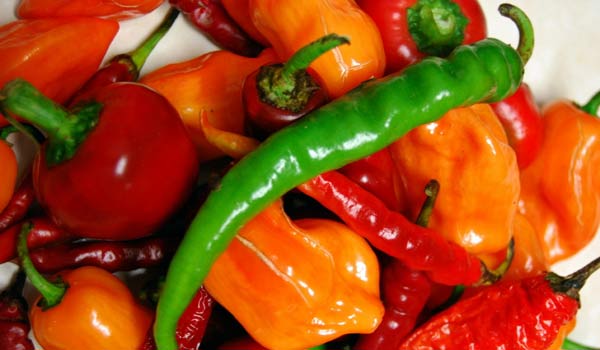Why Do Chili Peppers Taste Hot?

The culprit of the burning feeling you get from jalapeno-loaded Mexican food: chemical compounds called capsaicinoids. The odorless, flavorless substances are hidden in the white flesh inside of peppers. And when you pop a pepper into your mouth, the chemical binds to receptors that respond to pain from heat in the mouth and throat.
The brain gets the message and sends out the body’s “fire squad” to remove the hot substance, resulting in increased circulation (boosts metabolism), cooling perspiration and typical reactions to any irritant (runny nose and teary eyes).
The pain also leads to a release of endorphins, the body’s natural painkillers, which flood the diner with blissful feelings.
So those tears are actually tears of joy.
Not all peppers pack the same punch. In 1912, chemist Wilbur Scoville developed a measure of the “hotness” of a chili pepper called the Scoville Organoleptic Test. A pepper’s pungency is measured in multiples of 100 units and refers to how much sugar-water was needed to dilute the pepper to a point where the tasters could no longer taste (feel) the heat.
Some examples include:
- Sweet bell pepper — 0 units
- Jalapeno — 2,500 to about 8,000 units
- Cayenne — 30,000 to about 50,000 units
- Red Savina Habanero — 350,000 to about 577,000 units
Follow Life's Little Mysteries on Twitter @llmysteries. We're also on Facebook & Google+.
Get the world’s most fascinating discoveries delivered straight to your inbox.
Jeanna Bryner is managing editor of Scientific American. Previously she was editor in chief of Live Science and, prior to that, an editor at Scholastic's Science World magazine. Bryner has an English degree from Salisbury University, a master's degree in biogeochemistry and environmental sciences from the University of Maryland and a graduate science journalism degree from New York University. She has worked as a biologist in Florida, where she monitored wetlands and did field surveys for endangered species, including the gorgeous Florida Scrub Jay. She also received an ocean sciences journalism fellowship from the Woods Hole Oceanographic Institution. She is a firm believer that science is for everyone and that just about everything can be viewed through the lens of science.



